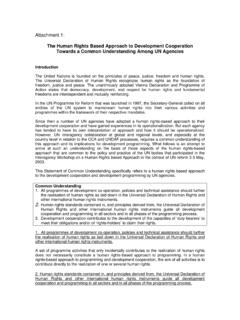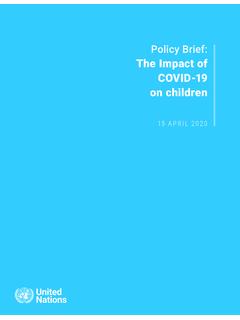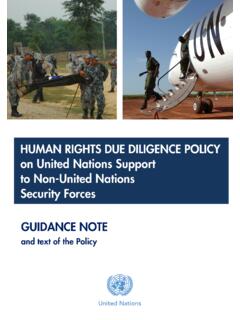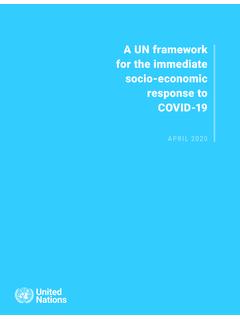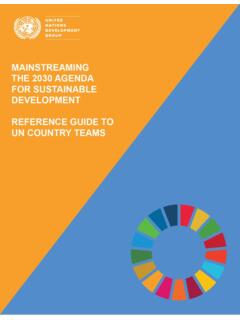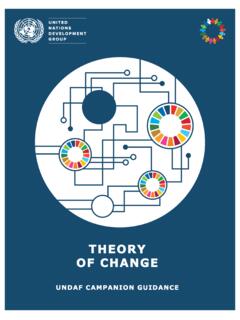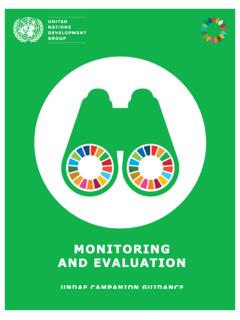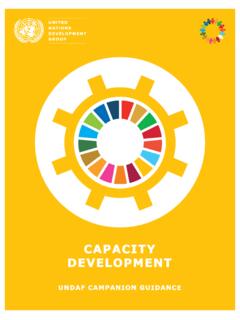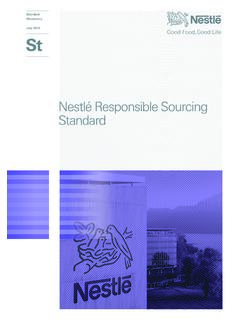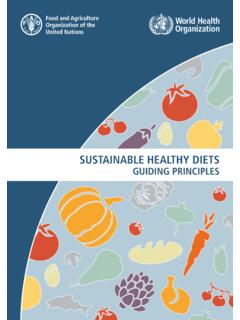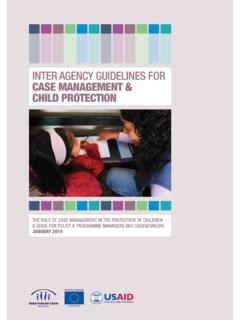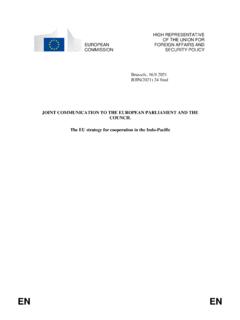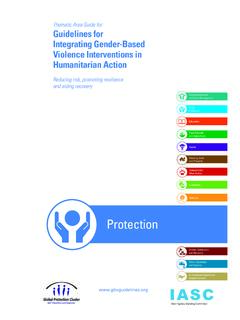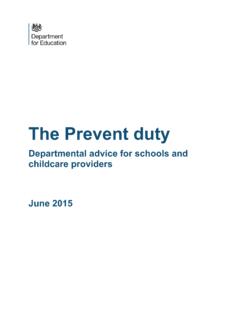Transcription of DATA PRIVACY, ETHICS AND PROTECTION GUIDANCE …
1 data privacy , ETHICS AND PROTECTION GUIDANCE NOTE ON BIG data FOR ACHIEVEMENT OF THE 2030 AGENDAThis document has been approved through the United Nations Development Group (UNDG) and applies to all member entities within the UNDG and its working mechanisms. The approval of this document is based on consensus among UNDG members and the provisions contained herein apply to all UNDG entities; FAO, IFAD, ILO, IOM, ITU, OHCHR, UNAIDS, UNCTAD, UNDESA, UNDP, UNECA, UNECE, UNECLAC, UNEP, UNESCAP, UNESCO, UNESCWA, UNICEF, UNIDO, UNFPA, UNHABITAT, UNHCR, UNODC, UN OHRLLS, UNOPS, UN OSAA, SRSG/CAC, UN Women, UNWTO, WFP, WHO and WMO. PURPOSE OF THIS GUIDANCE NOTE 2 principles 41. LAWFUL, LEGITIMATE AND FAIR USE 42. PURPOSE SPECIFICATION, USE LIMITATION AND PURPOSE COMPATIBILITY 43. RISK MITIGATION AND RISKS, HARMS AND BENEFITS ASSESSMENT 44.
2 SENSITIVE data AND SENSITIVE CONTEXTS 55. data SECURITY 56. data RETENTION AND data MINIMIZATION 67. data QUALITY 68. OPEN data , TRANSPARENCY AND ACCOUNTABILITY 79. DUE DILIGENCE FOR THIRD PARTY COLLABORATORS 7 DEFINITIONS & NOTES 8 ADDENDUM A 12 HOW data ANALYTICS CAN SUPPORT THE SDGs 12 BIBLIOGRAPHY 14 TABLE OFCONTENTS1 TABLE OF CONTENTSThis document sets out general GUIDANCE on data privacy , data PROTECTION and data ETHICS for the United Nations Development Group (UNDG) concerning the use of big data , collected in real time by private sector entities as part of their business offerings1, and shared with UNDG members for the purposes of strengthening operational implementation of their programmes to support the achievement of the 2030 Agenda2.
3 The GUIDANCE Note is designed to: Establish common principles across UNDG to support the operational use of big data for achievement of the Sustainable Development Goals (SDGs); Serve as a risk-management tool taking into account fundamental human rights ; and Set principles for obtaining, retention, use and quality control for data from the private data revolution was recognized as an enabler of the Sustainable Development Goals, not only to monitor progress but also to inclusively engage stakeholders at all levels to advance evidence-based policies and programmes and to reach the most The 2030 Agenda asserts that Quality, accessible, timely and reliable disaggregates data will be needed to help with the measurement of progress (SGDs) and to ensure that no one is left behind. Such data is key to decision making. 4 PURPOSE OF THIS GUIDANCE NOTEAt the same time, there are legitimate concerns regarding risks associated with handling and processing of big data , particularly in light of the current fragmented regulatory landscape and in the absence of a common set of principles on data privacy , ETHICS and PROTECTION .
4 These concerns continue to complicate efforts to develop standardized and scalable approaches to risk management and data access. A coordinated approach is required to ensure the emergence of frameworks for safe and responsible use of big data for the achievement of the 2030 Agenda. The GUIDANCE described in this document acknowledges and is based on the UN Guidelines for the Regulation of Computerized Personal data Files, adopted by the UN General Assembly resolution 45/95, and takes into account both existing international instruments and relevant regulations, rules and policies of UNDG member organizations concerning data privacy and data PROTECTION . This GUIDANCE Note is based on standards that have withstood the test of time, reflecting the strength of their core GUIDANCE Note is designed to support members and partners of the UNDG in establishing efficient and coherent data collaborations.
5 1 This GUIDANCE Note focuses on the use of big data collected by non-UN parties. Many of the guiding principles , however, may be applied in cases where UNDG members collect big data for the purposes of implementing their mandates, for example in the form of photographs or videos collected by unmanned aerial vehi-cles (UAVs).2 This GUIDANCE Note supports implementation of the Quadrennial Comprehensive Policy Review of the operational activities for development of the UN system ( ), particularly in its call for the UN funds, programmes and specialized agencies to strengthen their support to collect, analyse and increase significantly the availability of high-quality, timely and reliable disaggregated in so doing utilizing national capacities to the fullest extent possible in the context of United Nations operational activities for development.
6 3 Examples of how big data could be used to support the Sustainable Development Goals can be viewed in Addendum For more detail, see Transforming our World: The 2030 Agenda for Sustainable Development (A/RES/70/1, p. 11), available at The right to privacy is enshrined by the Universal Declaration of Human rights , Article 12 (UN General Assembly resolution 217 A(III), Paris, France, 10 December 1948.; the International Covenant on Civil and Political rights , Article 17 (General Assembly resolution 2200 A(XXI), New York, 19 December 1966, UN Treaty Series, vol. 999, No. 14668, p. 171 and vol. 1057, p. 4019); the convention on the rights of the child (art. 16), the International convention on the PROTECTION of All Migrant Workers and Members of Their Families (art. 14); European convention on Human rights (art. 8); the American convention on Human rights (art.))
7 11). 2 data privacy , ETHICS AND PROTECTION : GUIDANCE NOTE ON BIG data FOR ACHIEVEMENT OF THE 2030 AGENDA Reaffirming that the right to privacy is a fundamental human right and recognizing the social value of data , including the value of disaggregated SDG indicators with regard to the implementation of the 2030 Agenda, this document aims to provide a harmonized general framework for accountable, adequately transparent, and responsible data handling practices across the UNDG and with partners. This GUIDANCE Note is not a legal document. It provides only a minimum basis for self-regulation, and therefore may be expanded and elaborated on by the implementing organizations. Acknowledging the potential risks and harms as well as the benefits that can result from big data use, this document goes beyond individual privacy and considers potential effects on group(s) of individuals.
8 Additionally, this GUIDANCE takes into consideration standards of moral and ethical conduct, and recognizes the importance of context when big data is being used. It is recommended that this GUIDANCE Note be implemented through more detailed operational guidelines that account for the implementation of UNDG member organizations UNDG is grateful to UN Global Pulse for developing this GUIDANCE Note and acknowledges the invaluable contributions of the Global Pulse privacy Advisory Group as well as other private and public expert stakeholders. Any questions, comments or recommendations regarding this GUIDANCE Note should be directed to Sustainable Development Goal 17 aims to Strengthen the means of implementation and revitalize the global partnership for sustainable development . Target notes the need for data disaggregation by income, gender, age, race, ethnicity, migratory status, disability, geographic location and other characteristics relevant in national contexts (A/70 ).
9 7 For more information, see the Report of the Special Rapporteur on the right to priva-cy , Joseph A. Cannataci, Annex II. A more in-depth look at Open data and Big data (A/HRC/31/64, p. 24).mandates as well as their existing regulations, rules and policies concerning data privacy , data PROTECTION , data ETHICS and data security. It is recommended that designated legal, ETHICS , privacy and security experts be consulted, when necessary, regarding the implementation of, and compliance with, this Note. Implementing organizations are encouraged to establish a monitoring mechanism for compliance and implementation of this Note. Given continuous advances in technology and data , the international landscape concerning data privacy and data PROTECTION (including through the relevant work of the UN) may also change. Accordingly, this note is a living document and may also evolve over PURPOSE OF THIS GUIDANCE NOTE1.
10 LAWFUL, LEGITIMATE AND FAIR USEData access, analysis or other use must be consistent with the United Nations Charter and in furtherance of the Sustainable Development directly or through a contract with a third party data provider, data should be obtained, collected, analysed or other-wise used through lawful, legitimate and fair means. In particular, data access (or collection, where applicable), analysis or other use should be in compliance with applicable laws, including data privacy and data PROTECTION laws, as well as the highest standards of confidentiality and moral and ethical should always be accessed, analysed or otherwise used taking into account the legitimate interests of those individuals whose data is being used. Specifically, to ensure that data use is fair, data should not be used in a way that violates human rights , or in any other ways that are likely to cause unjustified or adverse effects on any individual(s) or group(s) of individuals.
